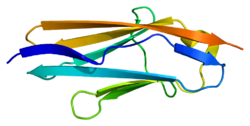SPEG Available structures PDB Ortholog search: PDBe RCSB
Identifiers Aliases SPEG External IDs OMIM : 615950 MGI : 109282 HomoloGene : 55619 GeneCards : SPEG Gene location (Human ) Chr. Chromosome 2 (human) [1] Band 2q35 Start 219,434,843 bp [1] End 219,493,629 bp [1]
Gene location (Mouse ) Chr. Chromosome 1 (mouse)[2] Band 1 C4|1 38.88 cM Start 75,375,297 bp [2] End 75,432,320 bp [2]
Gene ontology Molecular function Cellular component Biological process Sources:Amigo / QuickGO
Orthologs Species Human Mouse Entrez Ensembl UniProt RefSeq (mRNA) RefSeq (protein) Location (UCSC) Chr 2: 219.43 – 219.49 Mb Chr 1: 75.38 – 75.43 Mb PubMed search[3] [4] Wikidata
Striated muscle preferentially expressed protein kinase , in the human is encoded by the SPEG gene, a member of the myosin light chain kinase protein family.[5] [6] [7] muscle cell cytoskeleton ,[5] skeletal muscles , and their maintenance and function.[7] centronuclear myopathies a group of congenital disorders where the cell nuclei are abnormally centrally placed.[8]
In the mouse this gene is called SPEG complex locus .[9] vascular smooth muscle cells which may have a role in regulating growth and differentiation of this cell type. The encoded protein is highly similar to the corresponding rat and mouse proteins. Multiple alternatively spliced transcript variants have been found for this gene, but the full-length nature of only one variant has been defined.
Mouse Mutant Alleles for Speg
Marker Symbol for Mouse Gene. This symbol is assigned to the genomic locus by the MGI
Speg
Mutant Mouse Embryonic Stem Cell Clones. These are the known targeted mutations for this gene in a mouse.
Spegtm1a(KOMP)Wtsi
Example structure of targeted conditional mutant allele for this gene
These Mutant ES Cells can be studied directly or used to generate mice with this gene knocked out. Study of these mice can shed light on the function of Speg:
see Knockout mouse
References [ ]
^ a b c GRCh38: Ensembl release 89: ENSG00000072195 - Ensembl , May 2017^ a b c GRCm38: Ensembl release 89: ENSMUSG00000026207 - Ensembl , May 2017^ "Human PubMed Reference:" . National Center for Biotechnology Information, U.S. National Library of Medicine .^ "Mouse PubMed Reference:" . National Center for Biotechnology Information, U.S. National Library of Medicine .^ a b "SPEG striated muscle enriched protein kinase [Homo sapiens (human)] - Gene - NCBI" . www.ncbi.nlm.nih.gov . Retrieved 6 June 2021 .^ "SPEG - Striated muscle preferentially expressed protein kinase - Homo sapiens (Human) - SPEG gene & protein" . www.uniprot.org . Retrieved 6 June 2021 .^ a b Luo, S; Rosen, SM; Li, Q; Agrawal, PB (2021-05-27). "Striated Preferentially Expressed Protein Kinase (SPEG) in Muscle Development, Function, and Disease" . International Journal of Molecular Sciences . 22 (11): 5732. doi :10.3390/ijms22115732 PMC 8199188 PMID 34072258 . ^ Zhang, G; Xu, M; Huang, T; Lin, W; Chen, J; Chen, W; Chang, X (2021-04-29). "Clinical and genetic analysis of a case with centronuclear myopathy caused by SPEG gene mutation: a case report and literature review" . BMC Pediatrics . 21 (1): 209. doi :10.1186/s12887-021-02656-6 . PMC 8082920 PMID 33926407 . ^ "Speg SPEG complex locus [Mus musculus (house mouse)] - Gene - NCBI" . www.ncbi.nlm.nih.gov . Retrieved 6 June 2021 .
Further reading [ ]
Hsieh CM, Yoshizumi M, Endege WO, et al. (1996). "APEG-1, a novel gene preferentially expressed in aortic smooth muscle cells, is down-regulated by vascular injury" . J. Biol. Chem . 271 (29): 17354–9. doi :10.1074/jbc.271.29.17354 PMID 8663449 . Hsieh CM, Yet SF, Layne MD, et al. (1999). "Genomic cloning and promoter analysis of aortic preferentially expressed gene-1. Identification of a vascular smooth muscle-specific promoter mediated by an E box motif" . J. Biol. Chem . 274 (20): 14344–51. doi :10.1074/jbc.274.20.14344 PMID 10318857 . Nagase T, Kikuno R, Ishikawa KI, et al. (2000). "Prediction of the coding sequences of unidentified human genes. XVI. The complete sequences of 150 new cDNA clones from brain which code for large proteins in vitro" . DNA Res . 7 (1): 65–73. doi :10.1093/dnares/7.1.65 PMID 10718198 . Strausberg RL, Feingold EA, Grouse LH, et al. (2003). "Generation and initial analysis of more than 15,000 full-length human and mouse cDNA sequences" . Proc. Natl. Acad. Sci. U.S.A . 99 (26): 16899–903. doi :10.1073/pnas.242603899 PMC 139241 PMID 12477932 . Ota T, Suzuki Y, Nishikawa T, et al. (2004). "Complete sequencing and characterization of 21,243 full-length human cDNAs" . Nat. Genet . 36 (1): 40–5. doi :10.1038/ng1285 PMID 14702039 . Sutter SB, Raeker MO, Borisov AB, Russell MW (2005). "Orthologous relationship of obscurin and Unc-89: phylogeny of a novel family of tandem myosin light chain kinases" (PDF) . Dev. Genes Evol . 214 (7): 352–9. doi :10.1007/s00427-004-0413-5 . hdl :2027.42/47514 PMID 15185077 . S2CID 7676954 . Gerhard DS, Wagner L, Feingold EA, et al. (2004). "The Status, Quality, and Expansion of the NIH Full-Length cDNA Project: The Mammalian Gene Collection (MGC)" . Genome Res . 14 (10B): 2121–7. doi :10.1101/gr.2596504 . PMC 528928 PMID 15489334 . Arvanitis DA, Flouris GA, Spandidos DA (2005). "Genomic rearrangements on VCAM1, SELE, APEG1and AIF1 loci in atherosclerosis" . J. Cell. Mol. Med . 9 (1): 153–9. doi :10.1111/j.1582-4934.2005.tb00345.x . PMC 6741330 PMID 15784173 . Hillier LW, Graves TA, Fulton RS, et al. (2005). "Generation and annotation of the DNA sequences of human chromosomes 2 and 4" . Nature . 434 (7034): 724–31. Bibcode :2005Natur.434..724H . doi :10.1038/nature03466 PMID 15815621 . Manjasetty BA, Niesen FH, Scheich C, et al. (2006). "X-ray structure of engineered human Aortic Preferentially Expressed Protein-1 (APEG-1)" . BMC Struct. Biol . 5 : 21. doi :10.1186/1472-6807-5-21 . PMC 1352370 PMID 16354304 . Tam JL, Triantaphyllopoulos K, Todd H, et al. (2006). "The human desmin locus: gene organization and LCR-mediated transcriptional control" . Genomics . 87 (6): 733–46. doi :10.1016/j.ygeno.2006.01.009 PMID 16545539 .
External links [ ] SPEG UCSC Genome Browser .SPEG UCSC Genome Browser .
PDB gallery
1u2h : X-ray Structure of the N-terminally truncated human APEP-1
Enzymes
Activity Regulation Classification
EC number Enzyme superfamily Enzyme family List of enzymes Kinetics Types






